Locomotives of India
The Indian Railways primarily operates electric and diesel locomotives. Steam locomotives are operated on a few World Heritage sites and also run occasionally as heritage trains. A locomotive is also known as a loco or engine. The country's first steam locomotive ran on the Red Hill Railway (built by Arthur Cotton to transport granite for road-building) from Red Hills to the Chintadripet bridge in Madras in 1837.[1]
Classification
Locomotives were classified by track gauge, motive power, function and power (or model number) in a four- or five-letter code. The first letter denotes the track gauge. The second letter denotes motive power (diesel or electric), and the third letter denotes use (goods, passenger, mixed or shunting). The fourth letter denotes a locomotive's chronological model number.
In 2002, a new classification system was adopted. For newer diesel locomotives, the fourth letter denotes their horsepower range. Not all diesel locomotives were reclassified, and the fourth letter continues to denotes their model number.
A locomotive may have a fifth letter, generally denoting a technical variant, subclass or subtype: a variation in the basic model or series, or a different motor or manufacturer. Under the new system, the fifth letter further refines horsepower in 100-hp increments: A for 100 hp, B for 200 hp, C for 300 hp and so on. A WDP-3A is a 3,100 hp (2,300 kW) locomotive, and a WDM-3F is 3,600 hp (2,700 kW).
The system does not apply to steam locomotives, which are no longer used on main lines. They retain their original class names, such as M- or WP-class.
Syntax
- First letter (gauge):
- W – Indian gauge (wide) – 5 ft 6 in (1,676 mm)
- Y – metre gauge (yard) – 3 ft 3 3⁄8 in (1,000 mm)
- Z – 2 ft 6 in (762 mm) narrow gauge
- N – 2 ft (610 mm) narrow (toy) gauge
- Second letter (motive power):
- D – Diesel
- C – DC electric (DC overhead line)
- A – AC electric (AC overhead line)
- CA – DC and AC (AC or DC overhead line); CA is considered one letter
- B – Battery (rare)
- Third letter (job type):
In WDM 3A, W denotes broad gauge; D denotes diesel power; M denotes mixed use (goods and passenger service), and 3A denotes 3,100 hp (3,000 + 100). In WAP 5, W is broad gauge; A is AC electric; P is passenger service, and 5 indicates that the locomotive is the fifth model used.
Broad-gauge (5 ft 6 in) locomotives
Steam
Nineteenth-century railway companies ordered custom-built locomotives, usually from British manufacturers. The multiplicity of similar-but-not-identical designs increased manufacturing cost and slowed production. During the 1890s, British manufacturers were busy and Indian railway companies looked to Germany and the United States for locomotives.[2] Engines used were:
- Bengal Nagpur Railway:
- Class F: 0-6-0
- Class GM: 2-6-0 (probably modified)
- BNR class HSG: 2-8-0+0-8-2 Garratt, India's first successful Garratts
- Class M: 4-6-2 (probably modified)
- BNR class N: 4-8-0+0-8-4 Garratt, India's largest locomotive. One is preserved at the National Rail Museum, New Delhi
- BNR class NM: Similar to N class; ten were built in 1931 by Beyer Peacock, and it was withdrawn in the late 1960s.
- BNR class P: 4-8-2+2-8-4 Garratt; four were built by Beyer Peacock in 1939. During the early 1970s, they were at the Bhilai (BIA) shed before being withdrawn.
- Bombay, Baroda and Central India Railway:
- East Indian Railway Company:
- Class CT: 0-6-4T, probably converted to a superheater.
- EIR class G: 2-2-2T. First two named Express and Fairy Queen. Built in 1855, the latter is the world's oldest locomotive to be in working order. Later rebuilt by Perambur Loco Works. Housed at East Indian Railway (EIR)
- EIR class P: 4-6-0
- Great Indian Peninsula Railway:
- GIPR classes Y1, Y2, Y3, and Y4: 0-8-4T. Used on Thal Ghat as bankers for pushing trains up the Western Ghats.
- GIPR Class F and F3: 2-6-0
- GIPR class J1: 0-6-0
- Class D4: 4-6-0; one is named Hero.
- Class D5: 4-6-0 passenger locomotive
- Class E1: 4-4-2 Atlantic built by the North British Locomotive Company in 1907–8. Rebuilt with a superheater between 1925 and 1928.
- Class T: Tank locomotive used for hauling Mumbai suburban trains
- Class Y: 2-8-4T
- Crane tank: 0-6-0T; one is preserved at the National Rail Museum in New Delhi.
- Madras and Southern Mahratta Railway:
- Nizam's Guaranteed State Railway:
- NSR class A: 2-6-0T (No. 48, probably an Atlantic) preserved at the National Rail Museum, Delhi.
- North Western State Railway:
- Class EM: 4-4-2 (probably modified); one is preserved at the National Rail Museum
- NWR class GAS: 2-6-2+2-6-2 Garratt; one built in 1925, and retired in 1937.
- NWR class P: 2-4-0
- Class E1: 4-4-2
- Class N1: 4-8-0
- Oudh and Rohilkhand Railway:
- Class B26: 0-6-0; one is preserved at the National Rail Museum.
- Others:
- Class B: 2-6-0
- Class E: 2-4-0
- Class F: 2-8-2, built between 1926 and 1950 by Nasmyth Wilson for service on Central Railway (CR).
- Class G: 2-6-0, probably intended for freight
- Class NA2
- Class PTC: 2-6-4T, owned by Northern Railway (NR); probably a converted passenger locomotive
- Class Y2: 2-8-2T, reclassified L2
- Phoenix: 0-4-0T; one is at the National Rail Museum.
- Ramgotty: 2-2-0T; the National Rail Museum's oldest locomotive, it was converted to broad gauge.
- Sultan, Sahib and Sindh: Hauled the train from VT to Thana in 1853.
Designs
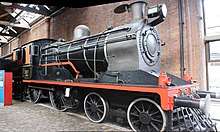
After acrimonious words in The Times and Parliament, the British Engineering Standards Committee (later the British Engineering Standards Association) began designing a series of locomotives for use by Indian railways. The first two designs emerged in 1903: a 4-4-0 passenger and 0-6-0 goods. They were revised in 1905 and 1906 with additional heavier, more-powerful locomotives:
- Class SP: Standard passenger (4-4-0)
- Class SG: Standard goods (0-6-0)
- Class PT: Passenger tank (2-6-4T)
- Class HP: Heavy passenger (4-6-0)
- Class AP: Atlantic passenger (4-4-2)
- Class HG: Heavy goods (2-8-0)
- Class HT: Heavy tank (2-8-2T)
These advisory BESA designs were customized by the railway companies, which used different classification systems; only the state-operated railways used the class designations SP, SG, PT, HP, AP, HG and HT. When superheating was accepted, superheated versions were classified SPS, SGS and so on (if built with superheaters) and SPC, SGC and so on (if converted from saturated to superheated).
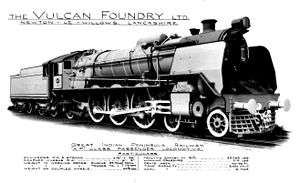
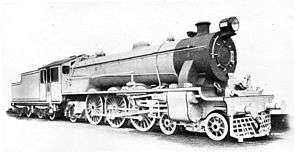
After World War I, larger and more-powerful locomotives were designed by British consulting engineers for the Indian government. They began to appear in 1927:
- Class XA: branch passenger 4-6-2 design, 12.5-ton axle load
- Class XB: light passenger 4-6-2 design, 17-ton axle load
- Class XC: heavy passenger 4-6-2 design, 19.5-ton axle load
- Class XD: Light goods 2-8-2 design, 17-ton axle load
- Class XE: heavy goods 2-8-2 design, 22.5-ton axle load
- Class XF: light shunting 0-8-0 design, 18-ton axle load
- Class XG: heavy shunting 0-8-0 design, 23-ton axle load
- Class XH: 4-cylinder 2-8-2, 28-ton axle load; none were built
- Class XP: experimental passenger 4-6-2, 18.5-ton axle load
- Class XS: experimental 4-cylinder 4-6-2, 21.5-ton axle load
- Class XT: light tank 0-4-2T, 15-ton axle load
During World War II, large numbers of 2-8-2 locomotives were acquired from the United States and Canada and classified AWD and CWD. The Baldwin Locomotive Works adapted the USATC S160 Class locomotive design for India, and it became class AWC. Sixty broad-gauge locomotives were built in 1944 as part of an order of 180 S160 engines. In addition to modified frame spreaders, axles, cylinders, and cab, the Indian locomotives had a turbo generator and electric lighting (not included in the standard European design). Many parts (including boilers) were identical to those in standard-gauge locomotives.[3]
Although new classes were designed shortly before the war, many did not enter service until the post-war period. The new classes were indicated by the change of broad-gauge prefix from X to W, and plans were implemented to begain manufacturing locomotives in India. The new classes were:
- Class WP: passenger 4-6-2, 18.50-ton axle load
- Class WG: goods 2-8-2, 18.50-ton axle load
- Class WL (1st): light 4-6-2, 16.00-ton axle load (four for North Western Railway in 1939; all to Pakistan during partition of India)
- Class WL (2nd): light 4-6-2, 16.75-ton axle load
- Class WM: 2-6-4T, 16.25-ton axle load
- Class WT: 2-8-4T, 18.00-ton axle load
- Class WU: 2-4-2T, 16.50-ton axle load
- Class WV: 2-6-2T, 16.25-ton axle load
- Class WW: 0-6-2T, 16.50-ton axle load
All broad-gauge steam locomotives in India have been withdrawn from normal service, with only occasional steam specials continuing to operate.
Diesel
Broad-gauge diesel classification codes are:
- WDM – Wide diesel mixed
- WDP – Wide diesel passenger
- WDG – Wide diesel goods
- WDS – Wide diesel shunter
- WCDS – Wide converted diesel shunter
Mixed locomotives are:
- WDM 1: India's first mainline diesel electric locomotives, introduced in 1957 and imported from ALCO. Out of service, the 1,950-horsepower (1,450 kW) locos' top speed was 110 km/h (68 mph).
- WDM-2: The country's most widely-used and first homemade mainline diesel-electric locomotives, the prototypes were made by ALCO. Introduced in 1962, over 2,700 have been manufactured and they are rated at 2,600 hp (1,900 kW).
- WDM-2A, WDM-2B: WDM-2 variants; the WDM-2A has dual brakes, and the 2B usually has air brakes.
- WDM-2G: Indian Railways' first Multi-Gen-set locomotive, manufactured by DLMW Patiala in 2013. In February 2014, two locos were in service: #80000 and #80001.[4] They have been approved for a maximum speed of 105 km/h (65 mph).[5]
- WDM-3: Eight were imported in 1970 from Henschel & Son. With a hydraulic transmission, the 2,500 hp (1,900 kW) engines have a maximum speed of 120 km/h (75 mph) and are currently unused.
- WDM-3A: Formerly known as the WDM-2C, it is a WDM-2 variant unrelated to the WDM-3. With a maximum speed of 120 km/h (75 mph), it has 30,450 kgf of tractive effort. Manufactured since 1994, it is one of India's most heavily-used diesel locomotives.
- WDM-3A R: Formerly the WDM-2, it is rebuilt with DBR on a short hood and is unrelated to the WDM-3.
- WDM-3B: Co-Co bogies with a top speed of 120 km/h (75 mph), they operate out of the Uttar Pradesh sheds. Twenty-three were built by DLW. Similar to the WDM-3D, they are rated at 3,100 hp (2,300 kW).[6]
- WDM-3C, WDM-3D: Higher-powered versions of the WDM-3A, rated at 3,300 hp (2,500 kW). The WDM-3C is rebuilt from the WDM-2. The WDM-3C and WDM-3D have maximum speeds of 120 km/h (75 mph) and 160 km/h (99 mph), respectively.
- WDM-3E: Reclassified as WDM-3D, it is restricted to freight at 105 km/h (65 mph). Eight 3,500 hp (2,600 kW) units were known to have been manufactured by DLW.
- WDM-3F: Manufactured by DLW, the 3,600 hp (2,700 kW) HAHS bogies have conventional DBR and air brakes.
- WDM-4: Entering service with the WDM-2, its 2,600 hp (1,900 kW) prototypes were designed by General Motors. Although it was considered superior to the WDM-2, General Motors did not agree to a technology transfer agreement.
- WDM-6: Two were made, and exported to Sri Lanka. Rated at 1,350 hp (1,010 kW), their maximum speed was 75 km/h (47 mph) and they had 19,200 kgf of tractive effort and Bo-Bo bogies.
- WDM-7: Fifteen 2,000 hp (1,500 kW) locos were built from June 1987 through 1989. Designed for branch-line duty, they are used primarily for shunting.
Passenger locomotives are:
- WDP-1: With Bo-Bo bogies and weighing 80 tons, their top speed is 120 km/h (75 mph). The 12-cylinder, 2,300 hp (1,700 kW) engines were built by DLW in 1970 and operate out of the Vijayawada and Tughlakabad sheds.
- WDP-2 (new class name WDP-3A: Entering service in 1998, the DLW loco has a maximum speed of 140 km/h (87 mph), 29.25 tons of tractive effort and is rated at 3,100 hp (2,300 kW).[7][8]
- WDP-3: WDP-1 prototypes, they were designed in 1996 by DLW. The 2,300 hp (1,700 kW) locos have Co-Co bogies.
- WDP-4: A 4,000 hp (3,000 kW) EMD (former GM-EMD) GT46PAC passenger version of the WDG-4 (GT46MAC)
- WDP-4B: Improved WDP-4 with 4,500 hp (3,400 kW), six traction motors (like the WDG-4), a wider cabin to aid visibility and minor exterior design changes. Production of the single-cab locomotives has ended.
- WDP 4D: A WDP-4 with twin cabs, the 4,500 hp (3,400 kW) locomotive with an LCD instrument display and driver toilet has entered serial production and regular service.
Goods locomotives are:
- WDG-2 (new class name WDG-3A): Upgraded WDM-2 built by DLW, with a maximum speed of 100 km/h (62 mph)
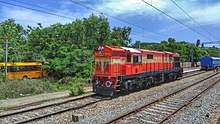
- WDG-3B, -3C and -3D: Upgraded WDG-2 or -3As. The WDG-3B and WDG-3C are rebuilt WDG-3As, and the WDG-3C is rated at 3,330 hp (2,480 kW).[9]
- WDG-4: General Motors 4,000–4,500 hp (3,000–3,400 kW) GT46MAC models, first imported in 1999 and numbered from #12000 to #12999 and upward from #70000.[10] Local production began in 2002.
- WDG-4D: A WDG-4 with dual air-conditioned cabs and a maximum speed of 100 km/h (62 mph), India's first dual-cab diesel freight engine[11]
- WDG-4G: Evolution Series ES43ACmi diesel locomotives which GE Transportation is building for Indian Railways
- WDG-5: Developed by Diesel Locomotive Works and supported by Electro Motive Diesels, the first unit left DLW on 25 February 2012. Numbered upwards from #50001, two were produced by 29 April 2015. Rated at 5,500 hp (4,100 kW), it has a fire control system, a TFT display and driver's toilet. The locomotive has entered serial production, and is assigned to the Sabarmati Diesel Loco Shed.
Shunting locomotives are:
- WDS-1: India's first widely-deployed diesel locomotive (imported in 1944–45), the 386 hp (288 kW) engine is out of service.
- WDS-2: With o-C-o bogies and an eight-cylinder engine, it is based at Central Railway. Built by Kraus Maffei in 1954–55, the 440 hp (330 kW) engine has 15,420 kgf of tractive effort and a maximum speed of 54 km/h (34 mph).
- WDS-3: The 618 hp (461 kW) locomotives of this class were rebuilt and reclassified as WDS-4C from 1976 to 1978. With 17,100 kgf of tractive effort, they were built in 1961.
- WDS-4, -4A, -4B and -4D: Designed by Chittaranjan Locomotive Works (CLW), the 600–700 hp (450–520 kW) locos have C bogies and were built from 1968 to 1997.
- WDS-4C: Rebuilt by CLW and reclassified from WDS-3, the 700 hp (520 kW) locomotive has 18,000 kgf of tractive effort and C bogies. Out of service, its maximum speed is 65 km/h (40 mph).
- WDS-5: Some are used for industrial shunting, and a few are used on Indian Railways. It is rated at 1,065 hp (794 kW).
- WDS-6: Heavy-haul shunters made in large numbers for industry and Indian Railways, it is rated at 1,200–1,350 hp (890–1,010 kW).
- WDS-6R, -6SL and -6AD: Variants of the WDS-6, the -6SL is exported to Sri Lanka. The -6AD has a maximum speed of 50 km/h (31 mph) and a six-cylinder engine.[12]
- WDS-8: Five 800 hp (600 kW) locos, with a maximum speed of 35 km/h (22 mph) and 22,000 kgf of tractive effort, were made by CLW and transferred to steelworks.
Several 250 hp (190 kW) hydraulic diesel shunters were in use at Integral Coach Factory, Diesel Locomotive Works and Chittaranjan Locomotive Works.[13] The WDS-1 to WDS-4D classes have a hydraulic transmission, and the WDS-4, -4B, -4C and -4D are the only extant broad-gauge diesel-hydraulic locomotives.
The WCDS6, a YDM4 locomotive, was converted to broad gauge by the Golden Rock Railway Workshop for large industrial companies; the first one was delivered to RITES. New water and air lines were added, the control stand was modified, and it has a dual brake system.
A few routes have DMU service. Depending on their transmission system, they are classified as DEMU (diesel-electric transmission) or DHMU (diesel-hydraulic transmission). There is diesel railcar service (known as railbus) in several areas.
DC electric
These locomotives, no longer in use, were used only in and around Mumbai with 1,500 V DC power. All sections of Central Railway, including Thane to Mumbai CST (Main Line), Nerul to Thane (Trans-Harbour Line), Vadala Road to Mahim (Harbour Line, connecting Central and Western Railway) and Panvel to Mumbai CST (Harbour Line) have been converted to 25 kV AC.
Mixed locomotives were:
- WCM 1: India's first electric Co-Co locomotives. Seven 3,350 hp (2,500 kW) engines were built by English Electric at Vulcan Foundry in 1954–55.
- WCM 2: Twelve 3,120 hp (2,330 kW) locomotives with Co-Co bogies and a maximum speed of 120 km/h (75 mph) were built by Vulcan Foundry in 1956–57 and modified by the Research Design and Standards Organisation (RDSO).
- WCM 3: Three 3,400 hp (2,500 kW) Co-Co locomotives with a maximum speed of 120 km/h (75 mph) were built by Hitachi in 1958, used in Kolkata and transferred to Mumbai.
- WCM 4: Seven 4,000 hp (3,000 kW) Co-Co locomotives, rated at 120 km/h (75 mph) and intended for freight with 31,300 kgf of tractive effort, were built by Hitachi in 1960.
- WCM 5: Built in 1962 by the Chittaranjan locomotive works to RDSO specifications, with auxiliaries by Westinghouse and North Boyce, the 3,700 hp (2,800 kW) Co-Co engines were India's first indigenously-designed DC electric locomotives.
- WCM 6: Two 4,700 hp (3,500 kW) locomotives were built in 1995 by CLW and converted to AC power. Initially rated at 105 km/h (65 mph), they are restricted to 65 km/h (40 mph).

Passenger locomotives were:
- WCP 1, WCP 2: GIPR EA/1 and EA/2, India's first electric locomotive. The first, the Sir Roger Lumley, is preserved at the National Rail Museum. The Swiss Locomotive and Machine Works (SLM) built one in 1928, 21 in 1930 (WCP 1) and one in 1938 (WCP 2). The 2,160 hp (1,610 kW) engine has a 1′Co2′ wheel arrangement.
- WCP 3, WCP 4: The GIPR EB/1 and EC/1 were among the earliest electric locos used in India. One of each class was built by Hawthorn Leslie and Company in 1928 with a 2′Co2′ wheel arrangement.
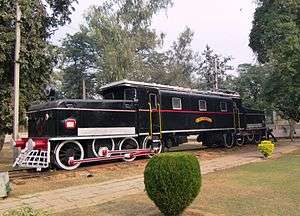
Goods locomotives were:
- WCG 1: GIPR EF/1, 2,600–2,950 hp (1,940–2,200 kW) Swiss crocodile locomotives imported in 1928 (10 from SLM and 30 from Vulcan Foundry). They were among India's earliest electric locomotives. The first, the Sir Leslie Wilson, is preserved at the National Rail Museum.
- WCG 2: Fifty-seven 4,200 hp (3,100 kW) locomotives with a maximum speed of 90 km/h (56 mph) and 35600 kgf of tractive effort were designed by the Chittaranjan locomotive works in 1970 and built until 1977.[14]. They were used extensively around 2000 in Mumbai.[15])
WCU 1 to WCU 15 electric multiple units (EMU) were used in the Mumbai region.
AC electric
A 25 kV AC system with overhead lines is used throughout the country. Mixed locomotives are:
- WAM-1: Among the first AC locomotives used in India, the 3,010 hp (2,240 kW) engines with a maximum speed of 112 km/h (70 mph) were introduced in 1959 and are out of service.
- WAM-2: Built by Mitsubishi between 1960 and 1964, the 2,910 hp (2,170 kW) locomotives with Bo-Bo bogies, 25,240 kgf of tractive effort and a maximum speed of 112 km/h (70 mph) are out of service.
- WAM-3: Similar to the WAM-2 except for reverse pantographs, the 1964 locomotive is also out of service.
- WAM-4: Designed by Chittaranjan Locomotive Works (CLW) in 1970, the 4,850 hp (3,620 kW) locomotive is one of India's most successful locomotives. Variants are the WAM-4B, -4P, -4PD, -4PR, -4PDBHS, -46PD, -4PDB3P, -42S3P, -46PDBHS, -46PE, -4G, -4H and -4E.
Passenger locomotives are:
- WAP-1: Designed by CLW in 1980 for the Kolkata-Delhi Rajdhani Express, the locomotive is rated 3,900 hp (2,900 kW) maximum, 3,760 hp (2,800 kW) continuous and has a maximum speed of 130 km/h (81 mph).
- WAP-2: Four units, decommissioned in the late 1980s and similar to the WAM-2 and 3 with Flexicoil Mark-II bogies and 2,910 hp (2,170 kW)
- WAP-3: Five WAP-1s have been rebuilt since 1987, with a maximum speed of 140 km/h (87 mph).
- WAP-4: Upgraded from the WAP-1 for heavier loads by CLW in 1994, the locomotive is rated 5,350 hp (3,990 kW) maximum and 5,000 hp (3,700 kW) continuous and has a speed limit of 150 km/h (93 mph).
- WAP-5: Imported in 1995 from Switzerland and used on express trains, the 6,000 hp (4,500 kW) maximum, 5,450 hp (4,060 kW) continuous locomotive with Bo-Bo bogies and a speed limit of 160 km/h (99 mph) has been built by CLW since 2000.
- WAP-6: Primarily rebuilt WAP-4s, 16 5,000 hp (3,700 kW) locomotives were built by CLW in 1997.
- WAP-7: Same design as the WAG-9, with a modified gear ratio. The 6,350 hp (4,740 kW) maximum, 6,000 hp (4,500 kW) continuous locomotives with a speed limit of 150 km/h (93 mph) have been built by CLW since 2000.
Goods locomotives are:
- WAG-1: Built between 1963 and 1966, India's first AC freight locomotive was rated 2,930 hp (2,180 kW) and had B-B bogies and a maximum speed of 80 km/h (50 mph). It was removed from service in 2002, and the WAG-1S is a variant.
- WAG-2: Built in 1964–65, the 3,450 hp (2,570 kW) locomotive with B-B bogies and a maximum speed of 80 km/h (50 mph) is out of service. The WAP-2 is a variant.
- WAG-3: Ten 3,590 hp (2,680 kW) locomotives with monomotor bogies, 30,000 kgf of tractive effort, over 6,000 tons of hauling capacity up to 70 km/h (43 mph) on level track and a maximum speed of 80 km/h (50 mph) were built in 1965. It is out of service. The WAG 3A is a variant.[16]
- WAG-4: Built by CLW between 1966–71, the 3,590 hp (2,680 kW) locomotive with B-B bogies and a maximum speed of 80 km/h (50 mph) is out of service. The WAG-4A and D are variants.
- WAG-5: India's most successful electric locomotives were designed by CLW in 1984. More than 1,100 were manufactured, and the WAG-5A, -5B, -5D, -5E, -5H, -5HA, -5HB, -5HD, -5HE, -5PE and -5RH are variants.
- WAG-6A: Imported from Allmänna Svenska Elektriska Aktiebolaget (ASEA), the 6,000 hp (4,500 kW) locomotive with a maximum speed of 100 km/h (62 mph) and Bo-Bo-Bo bogies has half-height vestibules.
- WAG-6B and -6C: Built by Hitachi in 1988, the 6,000 hp (4,500 kW) locomotive has air brakes, 44,950 kgf of tractive effort, a maximum speed of 100 km/h (62 mph) and full-height vestibules.
- WAG-7: Built by CLW and Bharat Heavy Electricals (BHEL), the 5,500 hp (4,100 kW) locomotive has 53,000 kgf of tractive effort, a maximum speed of 110 km/h (68 mph) and weighs 123 tons.
- WAG-7H: A 5,350 hp (3,990 kW) variant of the WAG-7 weighing 132 tons, with 91,000 kgf of tractive effort and a maximum speed of 110 km/h (68 mph). Ten units were built.
- WAG 8: Similar in appearance to the WCAM-2 and technically to the WCAM-3, the experimental locomotive built by BHEL in 1998 is out of service.
- WAG-9: India's most powerful class, rated at 6,350 hp (4,740 kW), it has the same design as the WAP-7 with a modified gear ratio and was designed by Adtranz, Switzerland.
- WAG-9H, WAG-9i and WAG-9Hi: Variants of the WAG-9, with the -9H the heavier version. The WAG-9i is fitted with IGBT traction converters. The WAG-9Hi is probably a combination of the WAG-9H and WAG-9i.[15]
- WAG-12 Prima: locomotives built by Alstom at the Madhepura locomotive factory in Bihar.[17]
Electric multiple units are designated WAU-1 to WAU-4.
Dual (AC and DC)
These locomotives are used only in the Mumbai. Their main purpose is to prevent the need to change engines. Mixed locomotives are:
- WCAM 1: Designed by Chittaranjan Locomotive Works, total 53 were built between 1975 and 1979. Decommissioned by Western Railway, it is the only locomotive with reverse pantographs.
- WCAM 2/2P: Designed by BHEL, 20 were built in 1995–96 and tested at 135 km/h (84 mph) on AC.
- WCAM 3: Fifty were designed by Bharat Heavy Electricals, rated at 4,600 hp (3,400 kW) on DC traction and 5,000 hp (3,700 kW) on AC. Owned by Central Railway, they are the most widely-used locomotive on the Mumbai-Pune section.
The WCAG 1 is a goods locomotive, with 12 designed by BHEL in 1999–2000. Similar to the WCAM 3 in outer structure, it is rated 4,600 hp (3,400 kW) on DC and 5,000 hp (3,700 kW) on AC.
In the Mumbai area, some EMUs can operate on dual traction.
Battery
In 1927, English Electric and WBC built two shunters for yard use in Bombay with Bo-Bo bogies. Rated at 240 hp (180 kW), they weighed 58 tons.[18]
Converted
- WAGC3: In 2018, Chittaranjan Locomotive Works, Diesel Locomotive Works and Research Design and Standards Organisation converted WDM-3A into purely electric 10,000HP (7,450kW) locomotive.[19]
Metre-gauge (3 ft 3⅜ in) locomotives
Steam
- Nilgiri Mountain Railway X class
- BESA designs:
- Passenger (4-6-0)
- Mixed (4-6-0)
- Goods (4-8-0)
- Tank (2-6-2T)
- Wartime designs:
- Class MAWD: 2-8-2 USATC S118 Class
- Class MWGX: 4-6-2+2-6-4 Garratt
- Indian Railway Standards designs
- Class YA: 4-6-2 with 9-ton axle load (none built)
- Class YB: 4-6-2 with 10-ton axle load
- Class YC: 4-6-2 with 12-ton axle load
- Class YD: 2-8-2 with 10-ton axle load
- Class YE: 2-8-2 with 12-ton axle load (none built)
- Class YF: 0-6-2; later examples were 2-6-2
- Class YK: 2-6-0 version of the 2-6-2 YF
- Class YL: 2-6-2
- Class YT: light 0-4-2T
- Class YG: 2-8-2 goods locomotivC
- Class YP: 4-6-2 passenger locomotive
Diesel
- YDM-1: The first metre-gauge diesel locomotives, 20 were imported from Britain in 1955. Used primarily on Western Railway, they were phased out by the 1990s.[20][21]
- YDM-2: Originally used on Southern Railway, 41 were built by CLW and used mainly used for shunting or pulling short passenger trains.[22][23]
- YDM-3: Produced by GM-EMD in 1961–62 as model GA-12, and mainly found near Ahmedabad at the Sabarmati Loco Shed).[22][24]
- YDM-4: India's most widely-used metre-gauge diesel locomotive, 550 units were produced by DLW (Varanasi) and Alco. Sheds include Mhow, Sabarmati Phulera, Lumding, Coonoor, Villupuram and Izatnagar.[22][25]
- YDM-4A: Ninety-nine locos were supplied by Montreal Locomotive Works from 1964 to 1969.[22][26]
- YDM-5: The same specifications as the YDM-3, with the addition of 10 tons to the axles, it was supplied by GM-EMD in 1964.[22][27]
Electric
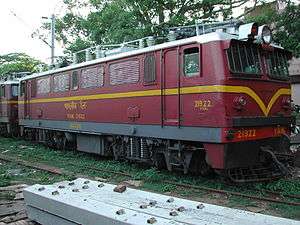
- Locomotives:
- YCG 1: Among India's earliest electric locomotives, the class was imported to serve the Chennai area in the early 1930s.
- YAM 1: Twenty 1,740 hp (1,300 kW) locomotives, imported from Japan, were in service until 2002 in the Chennai area.
- Electric multiple units:
- YAU class: India's first EMU service was introduced around 1920 in the Chennai area.
Narrow-gauge (2 ft 6 in and 2 ft) locomotives
Steam
2 ft 6 in
- Barsi Light Railway:
- Class A: 0-8-4T
- Class B: 4-8-4T
- Class C: 0-6-0ST
- Class D: 0-4-0
- Class E: Sentinel railcars
- Class F: 2-8-2
- Class G: 4-6-4
- Indian Railway Standards:
- Class ZA: 2-6-2 with 4.5-ton axle load (none built)
- Class ZB: 2-6-2 with 6-ton axle load
- Class ZC: 2-8-2 with 6-ton axle load (none built)
- Class ZD: 4-6-2 with 8-ton axle load (none built)
- Class ZE: 2-8-2 with 8-ton axle load
- Class ZF: 2-6-2T with 8-ton axle load
2 ft
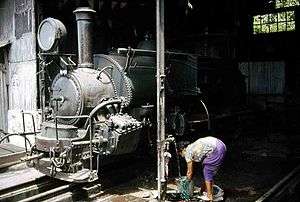
- Darjeeling Himalayan Railway:
- DHR A Class: 0-4-0WT;
- DHR B Class: 0-4-0ST; #777 and #778 preserved
- DHR C Class: 4-6-2
- DHR D Class: 0-4-0+0-4-0 Garratt
- Indian Railway Standards (none built):
- QA: 2-6-2 with 4.5-ton axle load
- QB: 2-6-2 with 6-ton axle load
- QC: 2-8-2 with 6-ton axle load
Diesel
2 ft 6 in
- ZDM-1 (at Gwalior Junction)
- ZDM-2 (Kalka Shimla Railway)
- ZDM-3 (rebuilt as ZDM 4C)
- ZDM-4 (at Gwalior Junction)
- ZDM-4A
- ZDM-4B, C, D
- ZDM-5
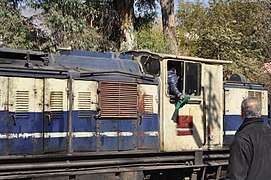 ZDM-2
ZDM-2 ZDM-3
ZDM-3- ZDM-4A
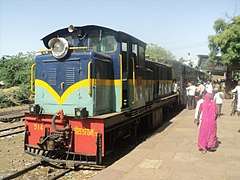 ZDM-5
ZDM-5
2 ft
- NDM-1: Matheran Hill Railway
- NDM-5: Gwalior Light Railway
- NDM-6: Darjeeling Himalayan and Matheran Hill Railways
Battery
- NBM-1: Designed by BHEL in 1987
Research and development
Indian Railways' diesel locomotives are fitted with auxiliary power units, which save nearly 88 percent on fuel when the trains are not running.[28]
See also
References
Notes
- ↑ "[IRFCA] India's First Railways". www.irfca.org.
- ↑ Hughes 1979, p. 17
- ↑ Baldwin Locomotive Works drawing index and bill of materials for special order 43306, locomotive design 2-8-0 19S, numbers 666 to 845 for the U.S. Government, War Department.
- ↑ http://www.irfca.org/apps/locos/show/12721
- ↑ http://www.rdso.indianrailways.gov.in/works/uploads/File/Speed%20Certificate%20of%20%20WDM2G%20loco.pdf
- ↑ "Vadakkus".
- ↑ http://www.irfca.org/faq/faq-loco2d.html
- ↑ "IRFCA Gallery".
- ↑ "24coaches".
- ↑ http://forum.irfca.org/showthread.php/31486-Ready-to-capture-WDG-4-70000?highlight=70000%5Bpermanent+dead+link%5D
- ↑ "IR Gazette".
- ↑ "DLW".
- ↑ "IRFCA diesel".
- ↑ "IRFCA2".
- 1 2 "IRFCA Loco Database".
- ↑ "Indian Railway".
- ↑ "In Bihar, PM Modi dedicates Madhepura electric loco factory to nation".
- ↑ "IRFCA".
- ↑ "Indian Railways creates history! Converts diesel loco to 'Make in India' electric locomotive; watch video". The Financial Express. 2018-03-03. Retrieved 2018-10-01.
- ↑ Meter Gauge Diesel Locomotives
- ↑ YDM-1
- 1 2 3 4 5 [IRFCA] Indian Railways FAQ: Locomotives – Specific classes : Meter Gauge & Narrow Gauge Diesel
- ↑ [IRFCA] Indian Railways FAQ: Diesel and Electric Locomotive Specifications
- ↑ [IRFCA] Indian Railways FAQ: Diesel and Electric Locomotive Specifications
- ↑ [IRFCA] Indian Railways FAQ: Diesel and Electric Locomotive Specifications
- ↑ [IRFCA] Indian Railways FAQ: Diesel and Electric Locomotive Specifications
- ↑ [IRFCA] Indian Railways FAQ: Diesel and Electric Locomotive Specifications
- ↑ "New Technology allows Railways to save Rs 20 Lakhs Diesel per Engine". Retrieved 6 September 2013.
Bibliography
- Hughes, Hugh (1976). Steam in India. Truro, Cornwall: D. Bradford Barton Ltd. ISBN 0851532586.
- Hughes, Hugh (1979). Steam locomotives in India, Part 3 – Broad Gauge. Harrow, Middlesex: The Continental Railway Circle. ISBN 0-9503469-4-2.
- Hughes, Hugh (1990). Indian Locomotives: Part 1 – Broad Gauge 1851–1940. Harrow, Middlesex: The Continental Railway Circle. ISBN 0-9503469-8-5.
- Hughes, Hugh (1992). Indian Locomotives: Part 2 – Metre Gauge 1872–1940. Harrow, Middlesex: The Continental Railway Circle. ISBN 0-9503469-9-3.
- Hughes, Hugh (1994). Indian Locomotives: Part 3 – Narrow Gauge 1863–1940. Harrow, Middlesex: The Continental Railway Circle. ISBN 0-9521655-0-3.
- Hughes, Hugh (1996). Indian Locomotives: Part 4 – 1941–1990. Harrow, Middlesex: The Continental Railway Circle. ISBN 0-9521655-1-1.
- Marshall, Lawrence G (2001). Indian Narrow Gauge Steam Remembered. East Harling, Norfolk: Plateway Press. ISBN 1871980488.
- Marshall, Lawrence G (2005). Indian Metre Gauge Steam Remembered. East Harling, Norfolk: Plateway Press. ISBN 1871980542.
- Marshall, Lawrence G (2009). Indian Broad Gauge Steam Remembered. East Harling, Norfolk: Taverner Publications. ISBN 9781901470154.
- Woods, George (2017). Indian Steam in the 1970s. Stroud, Glos: Amberley Publishing. ISBN 9781445666785.
External links
| Wikimedia Commons has media related to Locomotives of India. |


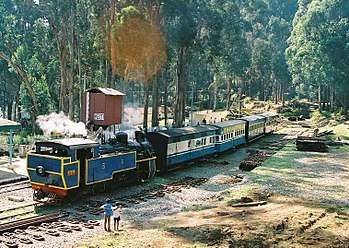
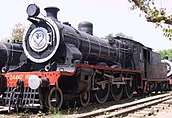

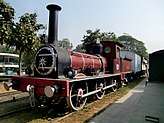
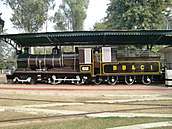
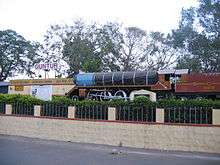
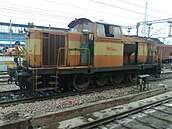
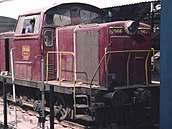
_DHMU_at_Malkajgiri_01.jpg)
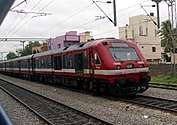
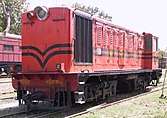

_Sathavahana_Express_at_Ghatkesar.jpg)
